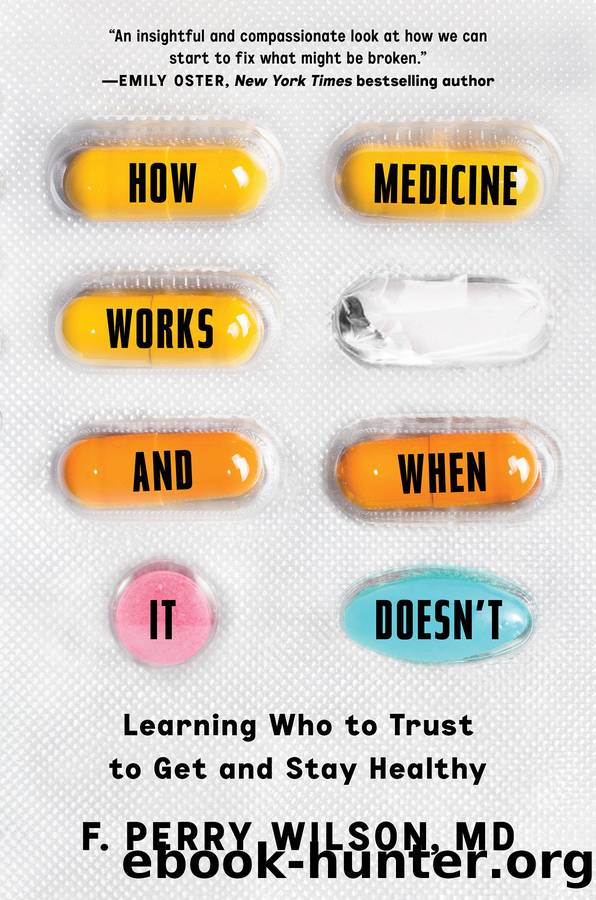How Medicine Works and When It Doesn't by F. Perry Wilson

Author:F. Perry Wilson [WILSON, F. PERRY, MD]
Language: eng
Format: epub
Publisher: Grand Central Publishing
Published: 2023-01-24T00:00:00+00:00
⢠Taking aspirin after a major heart attack: NNT 42 to save one extra life
⢠Antibiotics for sinus infections: NNT 15 to cure one extra patient
⢠Dexamethasone for hospitalized patients with COVID-19: NNT 36 to save one extra life
⢠CT scans for smokers to detect lung cancer early: NNT 217 to save one extra life
⢠Vitamins to prevent heart disease, stroke, or death: NNT infinity. (In other words, the major studies show no effect. But you knew that already.)
I mentioned earlier that the reason itâs a big secret that the medication youâre taking may not help you is because doctors donât really think about it. In part, this is because we are not trained to think in these particular terms. We are taught to learn what intervention works for a particular disease, and we internalize that as the standard of care. And evidence suggests we vastly overestimate the efficacy of these interventions.
A study that appeared in JAMA Network Open in 2021 brought this fact into stark relief. Five hundred forty-two clinicians were presented with a series of case scenarios and asked about therapeutic options. One, conveniently enough, presented a patient with mild hypertension. The clinician was asked how likely the patient was to have a cardiovascular event (stroke or heart attack) within the next ten years. The âtrueâ answer, based on epidemiologic data, is around 3 to 12 percent. The average answer among clinicians was 10 percent. So far, so goodâclinicians had a good sense of prognosis.
But the study then asked how likely the prescription of a blood-pressure-lowering drug would be to prevent a cardiovascular event. The average answer was 30 percent. Clinicians felt there was a one in three chance that the drug they prescribed would stave off a heart attack or stroke. In reality, as you know, the real chance is somewhere closer to 1 or 2 percent.
This doesnât mean the drug is bad. Many of us would do something that has a one in one hundred chance of saving our lives. Wearing your seat belt, for example, has an NNT of around 25,000 (after all, most people wonât die in car accidents whether they have a seat belt on or not), but we still do it, because it is cheap, easy, and basically without side effects.
The JAMA Network Open study shows that doctors, while accurate at predicting the likely outcomes of disease, overestimate the benefits of medications. This may be a subconscious effort to avoid despair at our weak anti-disease arsenal, but I think it has more to do with that population mindset again. And I believe that a major culprit, in fact, is the way results are reported in medical studies.
Download
This site does not store any files on its server. We only index and link to content provided by other sites. Please contact the content providers to delete copyright contents if any and email us, we'll remove relevant links or contents immediately.
| Anatomy | Animals |
| Bacteriology | Biochemistry |
| Bioelectricity | Bioinformatics |
| Biology | Biophysics |
| Biotechnology | Botany |
| Ecology | Genetics |
| Paleontology | Plants |
| Taxonomic Classification | Zoology |
Sapiens: A Brief History of Humankind by Yuval Noah Harari(14311)
The Tidewater Tales by John Barth(12625)
Mastermind: How to Think Like Sherlock Holmes by Maria Konnikova(7274)
Do No Harm Stories of Life, Death and Brain Surgery by Henry Marsh(6904)
The Thirst by Nesbo Jo(6876)
Why We Sleep: Unlocking the Power of Sleep and Dreams by Matthew Walker(6649)
Life 3.0: Being Human in the Age of Artificial Intelligence by Tegmark Max(5506)
Sapiens by Yuval Noah Harari(5320)
The Longevity Diet by Valter Longo(5038)
The Body: A Guide for Occupants by Bill Bryson(5025)
The Rules Do Not Apply by Ariel Levy(4906)
The Immortal Life of Henrietta Lacks by Rebecca Skloot(4547)
Animal Frequency by Melissa Alvarez(4424)
Why We Sleep by Matthew Walker(4393)
The Hacking of the American Mind by Robert H. Lustig(4334)
Yoga Anatomy by Kaminoff Leslie(4331)
All Creatures Great and Small by James Herriot(4266)
Double Down (Diary of a Wimpy Kid Book 11) by Jeff Kinney(4239)
Embedded Programming with Modern C++ Cookbook by Igor Viarheichyk(4136)
